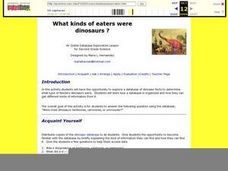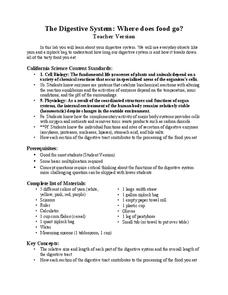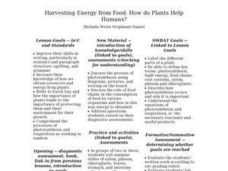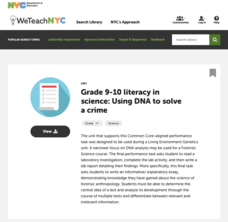Curated OER
Introduction to Human Anatomy & Physiology
If the only support you are in search of is lists of vocabulary terms, this presentation may fit the bill. Slides simply list terminology. These categories are included: hierarchy of structural organization, cell functions, cell...
Curated OER
Name that animal
A great way to classify organisms, is by counting the number of legs it has or how it moves. Little ones count the legs on five different creatures, then match the leg count to the proper animal name. Tip: Have them come up with other...
Curated OER
Shopping-Unit Pricing
Comparing unit prices of food products is a skill that learners will use for the rest of their lives. Here is a simple plan that provides practice calculating the unit price for various grocery store products. Use two jars with differing...
Curated OER
What Kind of Eaters Were Dinosaurs?
Second graders use a database to gather more information on dinosaurs. Using the information, they discover how the database is organized and how to get different information from it. They complete a worksheet with comprehension...
Curated OER
Food Webs
High schoolers are explained that they are spending the next few days researching an organism in preparation for a field trip. They are shown an overhead of the Field Guide. Students discuss what habitat means. They use their organism...
Curated OER
What Are Some Different Food Chains?
In this food chains worksheet, students compare and contrast examples of food chains in aquatic and terrestrial habitats. This worksheet is a graphic organizer.
Curated OER
How Do People Get Energy?
In this food energy learning exercise, students will write in examples of different foods that fit into the four food groups: grains, protein, fruits and vegetables, and milk products.
Curated OER
How Do Plants and Animals Get Energy?
In this food chain worksheet, students will determine where plants and animals get their energy by filling in the blank of 4 statements.
Curated OER
Can You Count on Cans?
How can a canned food drive be connected to math? It's as simple as counting and organizing the cans! Children demonstrate their ability to sort non-perishable foods into categories that include soup cans, vegetable cans, boxed items,...
Curated OER
Ecology
For use early in the year with your ecology class, this collection of slides introduces viewers to cycles in nature and relationships between organisms. There is a food web diagram, but the presentation is incomplete without any diagrams...
Curated OER
Science Jeopardy
Wow! Review an entire semester of biology curriculum playing this Science Jeopardy game! The variety of topics is extremely broad, so you will need to review each question to find if they all apply to your course. As you find material...
LABScI
The Digestive System: Where Does Food Go?
Would you believe that your digestive system stretches to five times your height?! Help your pupils to understand this relationship as they work through the laboratory exercise. The first instructional activity of a 12-part series is a...
Food Project
Introduction to Sustainable Agriculture and Food Systems
A series of hands-on, outdoor activities increase understanding of agricultural terms, soil management, pest control, and more. Plan ahead for this one as it requires a number of supplies and could be messy. Activities include...
Curated OER
Harvesting Energy from Food: How do Plants Help Humans?
Beginning botanists view slides of plant vascular tissue. They watch Magic School Bus Gets Planted, which you can find online, and then write a summary of what they have learned about plants. This lesson plan could be used with upper...
National Park Service
The Secret of Life
Dead trees provide nutrients for the soil, food for animals, protection and a home for organisms, a seed-bed for new trees, and a place for nitrogen-fixing bacteria to live. In the activity, pupils collect decaying logs, expose them to a...
Serendip
How Do We Sense the Flavors of Food?
We taste with our taste buds, so why do flavors change when we have a stuffy nose? Scholars experiment with taste testing while holding their noses and then while smelling. They record their observations in pairs and come together to...
Chicago Botanic Garden
Ecological Mismatches
Modeling is a powerful teaching tool. The final installment in a six-part series has pupils complete an activity to model a food web and discover the interconnected relationships in an ecosystem. They then read about changes in migratory...
Earth Day Network
The Neolithic Revolution
With the abundance of food products we can easily access in our society today, it is easy to forget the toll this can take on our global environment. Young learners will discover how the transition to agriculture and domesticated living...
Beyond Benign
Lucky Brand Genes: Chromosome Cookies
Mutations are not just deformed creatures we see in movies—they happen every day! Scholars study the different types of genetic mutations in the 12th installment of a series of 18 lessons. A creative activity uses candy and other food...
New York City Department of Education
Grade 9-10 Literacy in Science: Using DNA to Solve a Crime
Scholars become detectives and use science to solve a crime! A complete unit introduces DNA and includes hands-on activities that have learners model DNA and extract it from different food types. A culminating activity challenges...
Calculated Industries
Army Survival
Intended as a reference tool for US Army personnel, this application can be used in a classroom that is studying historic and current wars or as part of an outdoor education or wilderness survival course. Some of the subjects addressed...
Curated OER
Who I Am
Getting to know your class—and letting them get to know each other—is easy with an icebreaker worksheet. Topics include favorite food, subject, color, and book, as well as their birthday, role models, and favorite memories.
NOAA
Build Your Own Ocean Ecosystem
Hold the sea in the palm of your hand! Amateur oceanographers work together to create models of an ocean ecosystem in the sixth and final installment in a series. Raise awareness of global ocean health issues through guided research,...
College Board
2005 AP® English Language and Composition Free-Response Questions
Should people only have what they need? Questions from the 2005 AP® English Language and Composition Free-Response section asks scholars to write essays evaluating the argument that those who are more fortunate should give all excess...
Other popular searches
- Organic Food and Nutrition
- Con Pair Organic Foods
- Organic Foods Taste
- Non Organic Foods
- Com Pair Organic Foods
- California Organic Foods
- Compair Organic Foods
- Conpair Organic Foods
- Organic Foods Lesson Plan
- Organic Food Project
- Organic Matter Food Tests























